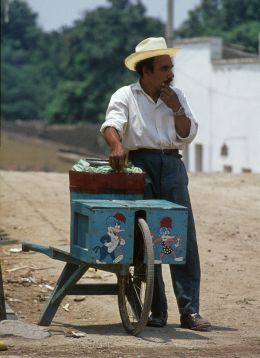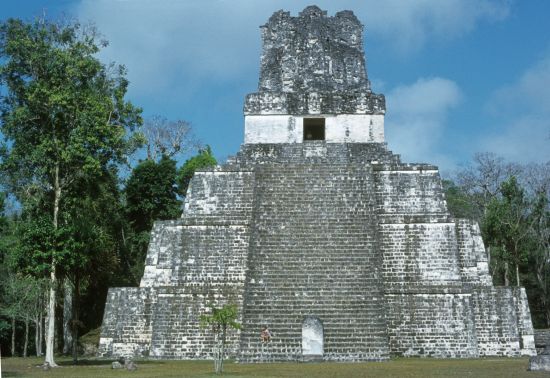| Barelds - Cycling around the world - Cycle stories - Asia, Africa, Europe, America | ||||||||||||||||||||
| home | site map | world | children | recent | cooking | dutch | german | react | ||||||||||||
Central and North America (4).

Mexico: He did not have much clientele until 2 Dutch cyclists dropped in.
We could only camp at few people who had a piece of land reclaimed at the road side. In the little courtyard, very close to the door in the hut of a Maya family, we were allowed to put up our tent. In the cool source we washed the dust and sweat from our faces after a tough day, a hummingbird did the same.
"Very nearby" the landlord told us, who came for a chat, "lies a Maya city in the jungle, which has never been excavated yet". Nothing disturbed the silence of the clear moon lit night, only the sawing and hammering in another hut, where a coffin was made for a baby who had just died.
Over an even narrower path, shaded by jungle giants and under a cacophony of singing birds, we reached the Maya city Tikal. We alighted to take a rest near a remote derelict temple. Majestically, mysterious, full of unknown hieroglyphs the temple looked down upon us, while we baked our meal of pancakes. Over narrow paths we cycled through the jungle from one temple to the other, because Tikal was by no means a small city in those days. Only the Maya didn't ride bicycles in those days, they did know the wheel, but only for toys!
Here also has been a Maya town" said the farmer in Belize on whose land we may camp,"under the hills is something and when I am ploughing I find very many flint stones". Unbelievable that the Mayas made these beautiful temples with flit-stone tools!
The maps of Belize showed asphalt roads, oncoming travellers spoke of terribly bad roads. When cycling, we looked very carefully and we saw that both were right. We rode on the wrong side of the road, because there were fewer rocks, when the police stopped us.
"Here the traffic is on the right", they remarked not very friendly.
"Yes but here the road is better to cycle on" we were so used to looking for the best stretch of road.
"We have nothing to do with that, and don't let me see you on the lefthand side again!"
"Well", we sighed "the status symbol "bicycle" is not very high in the pecking order" We had experienced this also on certain occasions such as the registration of our passports, which was, when a car driver came in, pushed aside.

Guatemala: The whole Yucatan was the area of the Maya city-states, everywhere in the jungle lie the ruins hidden, Tikal one of the most influential.
U
nder a tree near a hut, the bicycle was disassembled completely once again, the chain wheel slipped, a puncture and broken spokes. Our material began to wear out considerably and that cost many repair stops. A little boy stood watching us. He was sent by his mother to fetch water and carried a sack on a strap around his head, like all the women do who carry loads. His mum had to wait a long time for the water.A Maya woman joined us, wearing a white embroidered dress, a costume which must be 2000 years old: "Do you find it beautiful here?" she asked and without waiting for an answer, she continued, "I don't see anything beautiful here". Well it's true, the Yucatan of Mexico is not beautiful. A sea of low, withered jungle, partly burnt down for reclamation and cut with roads as straight as a line. The whole day straight on without a bend, without a village or a house and sometimes no water, rivers do not exist, all the water disappears into the porous chalk soil. The groundwater is brackish and drinking water, mostly rain water, had to be bought.
Within 10 km the repaired chain wheel slipped again, once again the patch got loose again and there was hardly any shade to be found. Repairing it cost a lot of sweat.
A little girl joined us: did we have any bread? That we had not eaten ourselves for days. "Why don't you eat tortillas", we asked her, because that was what we lived on now. Tortillas with kidney beans, a more hearty food a cyclist can hardly wish.
| Start World around | Central and North America | << Previous | Next page >> | |||
| Barelds on bicycle through the world - Cycling in Asia, Europe, Africa, America | ||||||